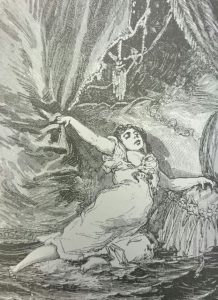Blackness is to hard to define and demonstrate with images, because the word only describes a status, but not a real material that can be touched or directly depicted by the use of language. However, Max Ernst, in his section of Thursday, uses a roster in almost every picture throughout the Thursday story as an observant. It quietly watches everything happening and turns into different forms. For example, on page 152, the roster becomes the main nobility in the scene, wearing a fancy fur and attending the scene as he is no longer an observant.
His existence suggests that the there is always brightness coming after the dark and the roster is the symbol of awaken and awareness of the hidden meanings of the whole book– what’s behind violence, blood, death and manhood?
The creation is about birth, hope and nature, but even though all seven days match the description in the creation, the themes are merely the same. For example, blackness– the word for Thursdays is all about monsters coming out of the darkness of the human minds. The roster can be the Max Ernst who sees through the frost and stands outside the crowd to reveal the truth. Also, the scenes in Thursdays contain mostly women who either are the victims or the witnesses of all the tragedy.
So what do you think about the meaning of the roster? And the hidden messages in other scenes?








